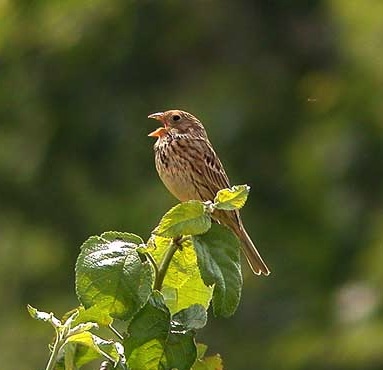45% of Europe’s landmass is given over to agriculture and changes in farming practices are placing a huge pressure on the biodiversity of the continent.
In Europe, more than 45% of land area is under agriculture (European Environment Agency 2006) and it is estimated that more than half of European species use farmland habitats (European Environment Agency 2005). The EU Common Agricultural Policy (CAP), alongside other economic and technological drivers, has led to profound changes in farm management practices. Land-use change driven by the CAP, intensification and abandonment of traditional low-intensity agriculture, has had negative effects on farmland biodiversity (Donald et al. 2002).
Successive reforms of the CAP sought to mitigate its environmental impacts. Restructuring of CAP mechanisms since the 1980s and 1990s has meant that direct subsidies, Pillar I of the CAP (72% of CAP budget: Atkin 2011), have been decoupled from agricultural production, and linked to compliance with rules for meeting environmental, public health and animal welfare standards (cross-compliance). In addition, agri-environmental measures, which support environmentally friendly farming practices, are a major component of Pillar II, the Rural Development Programme (RDP: European Commission 2007). Today, Pillar II is the most significant and important source of funding for the environment in rural areas and is critical for the delivery of environmental benefits across the EU countryside (Allen & Hart 2013).
The effectiveness of decoupling, cross-compliance and agri-environment measures has been heavily criticised, mainly owing to poor implementation and lack of funding (European Court of Auditors 2005, BirdLife International 2008, European Court of Auditors 2008, Boccaccio et al. 2009). The state of the environment in Europe continues to be degraded by agriculture and farming practices remain unsustainable (Matthews 2013). Given continuing environmental problems in the European countryside, increasing pressures brought about by climate change, uncertainties regarding food, water and energy security, and the economic crisis, the legitimacy of the budget allocation of the CAP (40% of the EU budget: European Commission 2007) and direct payments must be justified (Allen & Hart 2013, Matthews 2013).
There is a need to refocus the CAP towards the principle of ‘public money for public goods’. The European Commission set out draft legislative proposals for the CAP after 2013 that aim to deliver a greener agricultural sector (European Commission 2011). The main mechanism proposed was ‘greening’ of Pillar I, by making direct support conditional on three measures:
ÔÇó Crop diversification on arable land.
ÔÇó Maintenance of permanent grassland on agricultural holdings.
ÔÇó Management of 7% of holding area as Ecological Focus Areas (EFA).
Despite ‘greening’ measures, the proposals for CAP reform were met with disappointment by environmental NGOs (BirdLife International 2011, IEEP 2011). Concerns were raised that farmers may opt out of agri-environment measures in response to increased environmental obligations under Pillar I (EFRA 2012). Criticism has also been directed towards the lack of obligatory support for farmland within or neighbouring Natura 2000 areas (a EU-wide network of nature protection areas encompassing valuable and threatened habitats and species: European Commission 2009) and continued inadequate support for High Nature Value farmland through ‘less favoured area’ funding, which reflects geographical location rather than agricultural management practices (BirdLife International 2012).
Crucially, the proposals did not include provisions for minimum expenditure on agri-environment measures, the level of which is determined by each Member State (BirdLife International 2011). Furthermore, the funds allocated for environmental services under Pillar II are being diminished. Pillar II funding was cut disproportionately more than Pillar I during the EU budget negotiations in February 2013, Member States were allowed to shift funds from Pillar II to Pillar I, and the RDP includes more options to spend on production-related activities, potentially leaving little funding available for environmental measures (Baldock & Hart 2013).
During CAP reform negotiations, ‘greening’ has been substantially eroded by the European Parliament and Council. Cross-compliance measures under Pillar I have been weakened (Baldock & Hart 2013), while double funding is now possible, as the Council rejected the proposal that agri-environment measures to build on the environmental baseline set by Pillar I greening (Hart 2012). Furthermore, the effectiveness of the EFA measure, which could potentially deliver the greatest biodiversity benefits through the reformed CAP (Allen et al. 2012, Allen & Hart 2013), has been severely limited. The area has been reduced to 5%, many agricultural holdings have been excluded on the basis of size and geographical criteria, and continuation of production activities on EFA land has been approved without the requirement to demonstrate environmental benefits (Bureau 2013, Baldock & Hart 2013).
Negotiations continue until the trilogue in June 2013, when the European Parliament, European Council and European Commission will have the last chance to arrive at a final agreement for a coherent CAP that genuinely contributes towards environmental sustainability. Unfortunately, the outlook is bleak, as ‘greening’ measures appear to have been reduced to ‘green-wash’ and funds allocated to environmental public goods have shrunk (Baldock 2013). It is still possible for the trilogue to reverse some of the ‘watering down’ that has taken place to date. The CAP will then have the potential to deliver more environmental services, as well as greater resilience of agriculture to climate change (Baldock 2013, Baldock & Hart 2013).
References
Allen, B., Buckwell, A., Baldock, D. & Menadue, H. 2012. Maximising Environmental Benefits through Ecological Focus Areas. Report Commissioned by the Land Use Policy Group. London: Institute for European and Environmental Policy. View [accessed on 27 May 2013].
Allen, B. & Hart, K. 2013. Meeting the EU’s environmental challenges through the CAP – how do the reforms measure up? Aspects of Applied Biology 118: 9-22. View [accessed on 27 May 2013].
Atkin, C. 2011. New CAP, old hat? Some thoughts on the EU’s Common Agricultural Policy 2014-2020. International Journal of Agricultural Management 1: 7-10.
Baldock, D. 2013 Chances of a greener CAP are on the line. Brussels: EurActiv. View [accessed on 27 May 2013].
Baldock, D. & Hart, K. 2013. A Greener CAP: Still Within Reach? London: Institute for European and Environmental Policy. View [accessed on 27 May 2013].
BirdLife International. 2008. CAP Health Check – The Environment Gets a Placebo Treatment. Cambridge: BirdLife International. View [accessed on 30 November 2008].
BirdLife International. 2011. Common Agricultural Policy (CAP) Reform – Radical Re-think Needed to Make the CAP Really Deliver for the Environment. Cambridge: BirdLife International. View [accessed on 16 September 2011].
BirdLife International. 2012. Reform Proposals for the Common Agricultural Policy. Brussels: BirdLife International. View [accessed on 24 September 2012].
Boccaccio, L., Hegarty, J. & Brunner, A. 2009. Through the Green Smokescreen – How is CAP Cross Compliance Delivering for Biodiversity? Cambridge: BirdLife International. View [accessed on 16 September 2011].
Bureau, J.C. 2013. The Biodiversity Consequences of Killing Ecological Focus Areas. View [accessed on 27 May 2013].
Donald, P.F., Pisano, G., Rayment, M.D. & Pain, D.J. 2002. The Common Agricultural Policy, EU enlargement and the conservation of Europe’s farmland birds. Agriculture, Ecosystems & Environment 89: 167-182.
EFRA. 2012. Greening the Common Agricultural Policy – First Report of Session 2012-13. London: House of Commons Environment, Food and Rural Affairs Committee. View [accessed on 24 September 2012].
European Commission. 2007. The Common Agricultural Policy Explained. Brussels: European Commission. View [accessed on 18 July 2008].
European Commission. 2009. Natura 2000 – Europe’s Nature for You. Luxembourg: European Commission. View [accessed on 24 September 2012].
European Commission. 2011. Proposal for a Regulation of the European Parliament and of the Council Establishing Rules for Direct Payments to Farmers Under Support Schemes Within the Framework of the Common Agricultural Policy. COM (2011) 625 final/2. Brussels: European Commission. View [accessed on 20 November 2011].
European Court of Auditors. 2005. Special Report No. 3/2005 concerning rural development: the verification of agri-environment expenditure, together with the Commission’s replies. Official Journal of the European Union C 279: 1-29. View [accessed on 18 July 2008].
European Court of Auditors. 2008. Special Report No. 8/2008 (pursuant to Article 248(4), second subparagraph, EC) Is Cross Compliance an Effective Policy? Together With the Commission’s Replies. Luxembourg: European Court of Auditors. View [accessed on 18 July 2008].
European Environment Agency. 2005. Agriculture and Environment in EU-15 – the IRENA Indicator Report. Copenhagen: European Environment Agency. View [accessed 18 July 2008].
European Environment Agency. 2006. Progress towards Halting the Loss of Biodiversity by 2010. EEA Report No. 5/2006. Luxembourg: European Union Directorate-General Environment, Nuclear Safety and Civil Protection. View [accessed on 18 July 2008].
Hart, K. 2012. Principles of Double Funding. Briefing for the UK Land Use Policy Group. London: Institute for European and Environmental Policy. View [accessed on 27 May 2013].
IEEP. 2011. Radical Re-think Needed to Make the CAP Really Deliver for the Environment. London: Institute of European Environmental Policy. View [accessed on 16 September 2011].
Matthews, A. 2013. Greening CAP Payments – A Missed Opportunity? Dublin: The Institute of International and European Affairs. View [accessed on 27 May 2013].
Image: Corn Bunting © Steve Dudley
Blog with #theBOUblog
If you want to write about your research in #theBOUblog, then please see here.





